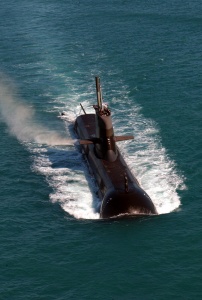
Based at Fleet Base West in Western Australia, HMAS Dechaineux is the fourth of the Collins Class submarines to enter service in the Royal Australian Navy and they are a formidable element in Australia"s defence capability.
Dechaineux was launched in Adelaide by Captain Dechaineux"s widow, Mrs Mary Purbrick on 12 March 1998 and commissioned at Fleet Base West on 23 February 2001 along with the fifth Collins Class submarine, HMAS Sheean. The ceremony was also attended by other members of Captain Dechaineux"s family.
HMAS Dechaineux"s operational characteristics and range have been tailored specifically for its defence and two-ocean surveillance role in the Royal Australian Navy. Designed to be as quiet as advanced technology can achieve, Collins Class submarines have been developed from five generations of submarines designed and built by the Swedish Navy.
One of the first submarines to be totally designed by computers, HMAS Dechaineux boasts a vast range of features. They include a high-performance hull form, highly automated controls, low indiscretion rates, high shock resistance, optimal noise suppression and an efficient weapons handling and discharge system.
The submarine moves silently on electric power supplied to the propulsion motor by banks of new technology lead-free batteries. The batteries are charged by three onboard diesel generator sets.
The sophisticated combat system gathers its intelligence from its sensors, computes the input and then launches and directs weapons.
Since commissioning, HMAS Dechaineux has successfully conducted a range of activities throughout the region in support of Australian Defence Force exercises, operations and the government"s strategic directives.
HMAS Dechaineux is named after Captain Emile Dechaineux, the Commanding Officer of HMAS Australia (II) during the latter stages of World War II. Captain Dechaineux was renowned for fairness and compassion towards his men and for his bravery and dedication. He died of wounds received during an attack by a Japanese dive bomber aircraft during the Allied amphibious landing at Leyte in the Central Philippines. He was posthumously awarded the Legion of Merit (Degree of Officer) by the United States Government.
History of the Crest
The Blazon
Per fess argent and azure; fess wavy of two azure and argent, a Tasmanian tiger erect, dexter forearm resting on an officers sword, point downwards.
Motif Description
The "Barry Wavy" represents the Navy and the sea. The field colours of yellow, blue and white represent: yellow for gold ining, white for tin operations and blue for the river and the sea. These all have association with Launceston, Tasmania where Captain Dechaineux was born. The Tasmanian Tiger is derived from the Coat of Arms of Launceston. The sword indicates that Dechaineux was an officer.
Specifications
 |
| Class |
Collins Class |
|---|---|
| Type |
Guided Missile Submarine, Diesel-Electric (SSG) |
| Role | Undersea Warfare |
| Pennant |
S76 |
| International Callsign |
VMLD |
| Motto |
Fearless and Ferocious |
| Home Port |
Fleet Base West |
| Builder |
Australian Submarine Corp, Adelaide |
| Laid Down |
4 March 1993 |
| Launched |
12 March 1998 |
| Launched by |
Mrs Mary Purbrick (Widow of CAPT Dechaineux) |
| Commissioned |
23 February 2001 |
| Dimensions & Displacement | |
| Displacement |
|
| Length | 77.8 metres |
| Beam | 7.8 metres |
| Draught | 7 metres |
| Performance | |
| Speed |
|
| Range |
|
| Complement | |
| Crew |
|
| Propulsion | |
| Machinery |
|
| Armament | |
| Missiles | McDonnell Douglas Sub Harpoon Block 1B (UGM 84C); active radar homing |
| Torpedoes | 6-21 in (533 mm) fwd tubes. Gould Mk 48 Mod 4/6/7; dual purpose; wire-guided; active/passive homing |
| Mines | 44 in lieu of torpedoes. |
| Physical Countermeasures | Decoys: 2 SSE. |
| Electronic Countermeasures | ESM: Condor CS-5600; intercept and warning. |
| Radars | Navigation: Kelvin Hughes Type 1007; I-band. |
| Sonars |
|
| Weapon Control Systems | AN-BYG 1. Link 11 |
| Resources | |
| News Articles |
Defence News |
| Image Gallery |
HMAS Dechaineux |



